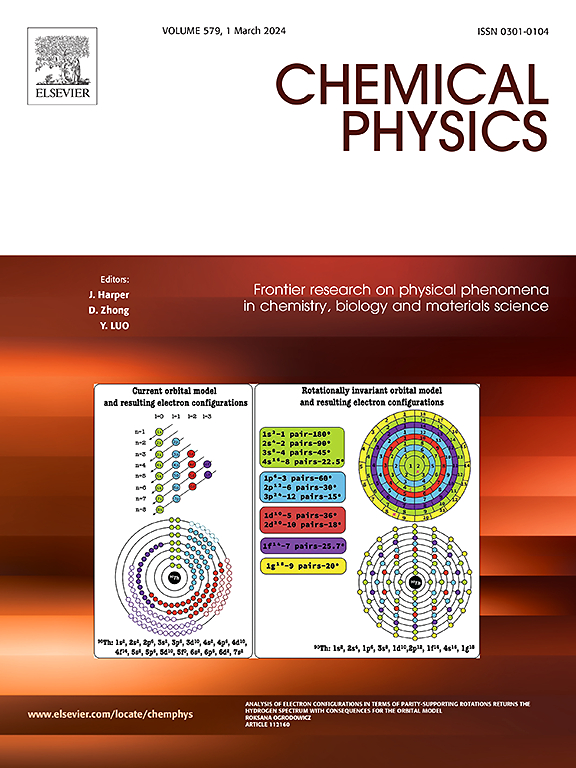Z-scheme WSTe/MoSSe van der Waals heterojunction as a hydrogen evolution photocatalyst: First-principles predictions
IF 2.4
3区 化学
Q4 CHEMISTRY, PHYSICAL
引用次数: 0
Abstract
WSTe/MoSSe heterojunction is constructed, covering four contact modes. The calculated built-in electric field (EIF) and interlayer spacing (h) validate the van der Waals (vdWs) heterojunction formation. In the analysis of interfacial charge behavior, the electrostatic interaction of Janus material heterojunction significantly affects charge transfer. Systematic analysis of density of states (DOS) and band structure reveals that all four contact configurations form type-II heterojunctions. By calculating conduction band offset (CBO) and valence band offset (VBO), it is found that the heterostructure in S![]() se contact mode is more favorable to hydrogen evolution, the analysis of differential charge density and band alignment further confirms the Z-scheme charge transfer mechanism in the heterojunction material system. Further investigations reveal 0.5 eV and 1.0 eV overpotentials for reduction and oxidation processes, respectively. The introduction of Ue (0.5 V) lowers the Gibbs free energy in the WSTe/MoSSe heterojunction system, demonstrating its spontaneous water-splitting capability under light exposure. Thermodynamic driving force enables autonomous photocatalysis, enhancing hydrogen production efficiency and positioning the material for solar energy conversion
se contact mode is more favorable to hydrogen evolution, the analysis of differential charge density and band alignment further confirms the Z-scheme charge transfer mechanism in the heterojunction material system. Further investigations reveal 0.5 eV and 1.0 eV overpotentials for reduction and oxidation processes, respectively. The introduction of Ue (0.5 V) lowers the Gibbs free energy in the WSTe/MoSSe heterojunction system, demonstrating its spontaneous water-splitting capability under light exposure. Thermodynamic driving force enables autonomous photocatalysis, enhancing hydrogen production efficiency and positioning the material for solar energy conversion
Z-scheme WSTe/MoSSe范德华异质结作为析氢光催化剂:第一性原理预测
构建了WSTe/MoSSe异质结,覆盖了四种接触模式。计算得到的内置电场(EIF)和层间间距(h)验证了范德华异质结的形成。在界面电荷行为分析中,Janus材料异质结的静电相互作用对电荷转移有显著影响。系统的态密度(DOS)和能带结构分析表明,四种接触构型均形成ii型异质结。通过计算导带偏移量(CBO)和价带偏移量(VBO),发现Sse接触模式下的异质结构更有利于析氢,电荷密度差和能带对准分析进一步证实了异质结材料体系中Z-scheme电荷转移机制。进一步研究发现还原和氧化过程的过电位分别为0.5 eV和1.0 eV。引入Ue (0.5 V)降低了WSTe/MoSSe异质结体系的吉布斯自由能,证明了其在光照射下的自发水分解能力。热力学驱动力实现自主光催化,提高制氢效率,定位太阳能转换材料
本文章由计算机程序翻译,如有差异,请以英文原文为准。
求助全文
约1分钟内获得全文
求助全文
来源期刊

Chemical Physics
化学-物理:原子、分子和化学物理
CiteScore
4.60
自引率
4.30%
发文量
278
审稿时长
39 days
期刊介绍:
Chemical Physics publishes experimental and theoretical papers on all aspects of chemical physics. In this journal, experiments are related to theory, and in turn theoretical papers are related to present or future experiments. Subjects covered include: spectroscopy and molecular structure, interacting systems, relaxation phenomena, biological systems, materials, fundamental problems in molecular reactivity, molecular quantum theory and statistical mechanics. Computational chemistry studies of routine character are not appropriate for this journal.
 求助内容:
求助内容: 应助结果提醒方式:
应助结果提醒方式:


